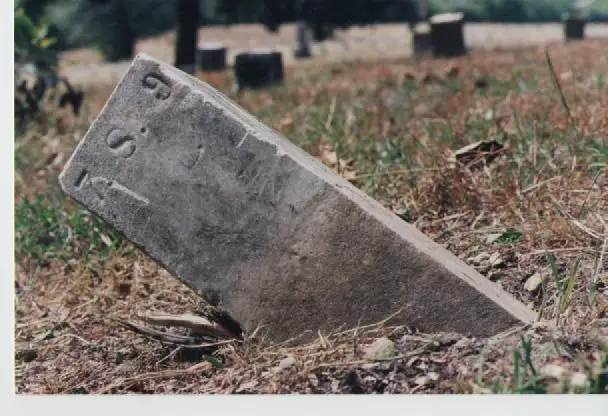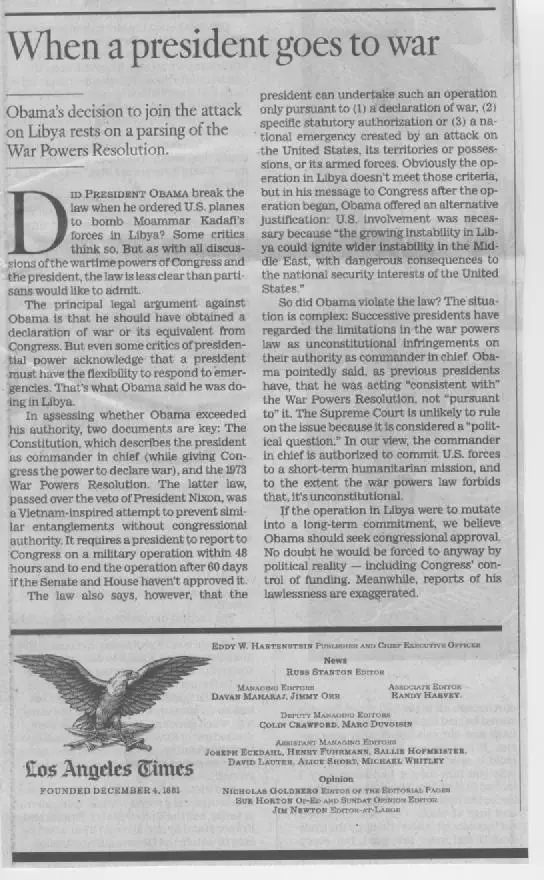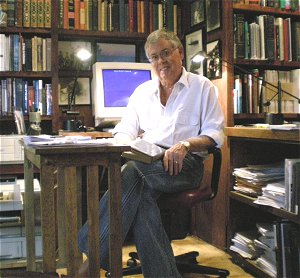What’s War Good For?
I
Richmond
|
Escorted into the library of the Virginia Historical Society, I was shown to a table where several folders were laid out and left alone to peruse the contents. Lee’s papers are scraps really—no exposition in the General’s hand of his war-time thinking; just two and a half pages showing his calculations of how many men were killed here, how many wounded there. One page of General Lee’s notes, though, is interesting: he writes he thought the government of the United States was the creation of the States, and, therefore, it had no lawful power to force itself upon the States. Abraham Lincoln claimed to think otherwise, of course. It was a bleak day when Lincoln stood on the Capital steps in front of a small crowd of spectators and gave his first inaugural speech. Starting with lawyer talk he told his audience, “The government’s perpetuity is implied, if not expressed. . . It follows, then, that no State, upon its own mere motion, can lawfully get out of the Union.” Here Lincoln paused, and, his voice rising in timber, he shifted his argument to a more honest ground. The meager audience heard his voice ring with these words: “Whenever the people grow weary of the existing government, they can exercise their revolutionary right to change it.” Sure they can, if they have the power, he had said years earlier. And, of course, by 1861, the people of the Northern states had the power to change it and Lincoln meant to lead them to do it. Knowing he had a bad legal case, in his inaugural address, Lincoln had planted his stance on the ground of sound political science; given the history of the American Revolution, he knew it was silly to assert that the men who framed the constitution, in 1787, meant to authorize—by implication no less—the creature of their creation to use the force of war to prevent the secession of a State from the Union. Silly, because the framers could hardly have expected the people of the several States to ratify a constitution pregnant with legal power to use the armed forces of their new general government against them. Certainly, the people of Virginia, whose delegates were the first to propose the substance of the constitution, would never have assented to the creation of such a government; and yet, American history having begun with a government being changed by revolution, there was precedent for the majority changing it by revolution again. General Lee certainly agreed with this principle of politics, as shown by this scribbled sentence found in his sparse writings: “The people of the states are themselves the judges of the government’s performance of its covenant.” Lee and Lincoln had ideas much in common. II Gaines Mill
Regrouping again and again, the remnants came on, until, at last, Hood’s crazy Texans broke through the center of Porter’s defenses and swarmed over the guns, grappling in hand to hand combat with the Union cannoneers, while Longstreet’s men penetrated Porter’s left flank and D.H. Hill’s men broke through his right.
III The Burke & Hebert Bank Two hours later, I reached Alexandria and stopped at the old Burke’s bank where General Lee’s so-called trunk had been found. It is a small building, with a stone foundation with window gratings evidencing a basement of some kind.
Walking in, I stood for a moment and looked around. The interior is a large room with brass grill work covering a teller’s counter that wraps like a horse shoe around the room. The décor hadn’t been changed, it appeared, since the building was constructed in the 1920s. I shook my head and walked out. It hardly seems possible that a trunk could be left unnoticed for so long in the basement of such a small busy place. Why the Lee descendants―they sit on the bank’s board of directors―practice the charade though, is beyond my ken completely; but charade it obviously must be as the surface of the trunk plainly shows it did not belong to Lee or his daughter. Perhaps it belonged to the Mary Lee who was the daughter of one of Lee’s sons. (See, Mary Coulling’s The Lee Girls, John Blair Publisher 1987) Perhaps, it is just that they enjoy being dramatic as they let go of the last of General Lee’s effects. IV Arlington
Walking round the amphitheater, I looked up at the white-marbled colonnade and read the names of the battles inscripted there: Malvern Hill, Antietam, Gettysburg, Petersburg are there, sorts of Union victories; but no Gaines Mill, Bull Run or Manassas, Fredericksburg, Chancellorsville or Cold Harbor.
I moved on. A hundred yards further into the deepest section of the cemetery, back where the stone wall border is found, I came upon what I was looking for. Set in a circle of grass, inside a loop in the road and surrounded by concentric circles of white headstones, a huge urn or bell-shaped jar loomed against the gun metal sky. The names of the dead were unknown, only the names of Confederate states were inscribed on the white stones: Mississippi, North Carolina, Tennessee, and Virginia.
Below the figure of the woman standing on the
pedestal, there is the life-sized form of another woman. Standing in front of
the urn on the edge of its block base, she is dressed in the garb of an
Athenian warrior; a helmet on her head, a spear gripped in her right hand, she
resembles the image of Virginia seen on the State’s blue flag. Her left hand
cradles the
On the back side of the urn―this is the side that faces the Capital Mall―these words are cut in the black stone: “We came in simple obedience to duty as we understood it, dared all and died.” An echo of Lincoln’s speech to the New Yorkers at Cooper Union, in which he closed with these words: “We must not be scared from our duty by false accusations, nor frightened from it by threats of destruction to ourselves. Let us have faith that right makes might, and in that faith let us to the end dare to do our duty as we understand it.” Easy for Lincoln to say, when he knew the North had the might: had the might because Virginia gave away the brace of states that held the balance of power. Yes, with her gesture Virginia seems to say, let the old constitution go. Indeed, what Americans living cannot see that the ultimate question we can ask about the Civil War, is, Did it change the Constitution? Yes, the answer must unequivocally be. It provided the forum in which the new framers rewrote the constitution with their blood, making African Negro slaves citizens of the United States. As General Lee is said to have put it: "The war was the result of the people's displeasure with the covenants of the Constitution as the framers wrote it, which they resolved through their force of arms on the battlefield."
Walking on, past Arlington House, I saw a small sign at a gravel path behind the slave quarters. The sign read simply, “museum.” I went down the path to a square brick building. Passing the plot of ground that used to be the Lee family’s kitchen garden, I opened the door and stepped in to the interior. On the wall as you enter, there is shown the text of a resolution, passed by Congress in 1955, the year after Brown v. Board of Education, making Arlington House an official federal government memorial to the memory of General Lee, and the little brick building a depository of Lee family possessions. Unlike the exhibits in the prominent slave quarters, featuring photographs of Custis family slaves, few visitors are likely to notice the sign that leads to this obscure little building on the grounds of Arlington.
Passing the old Custis mansion again, going back down the side of the hill, I came upon the horseman statute of Philip Kearny who was killed every early in the war. Kearny was not a particularly successful soldier, never commanding more than a division and that only for a month. Yet, in 1908, though he hardly was a citizen of the state, New Jersey erected the statute here, with the inscription: “New Jersey’s most distinguished soldier.” What? Does George McClellan, the commander of the Army of the Potomac, the victor at Antietam, and once governor of New Jersey and buried in Trenton, lay forgotten in his grave, or just insulted? The ribbon of battlefield names on the Amphitheater’s colonnade, the Confederate Monument in the back section, the abandoned tomb of the unknown soldiers, the hidden little museum, Kearny’s statute―why would Congress promote the placement of these things in Arlington National Cemetery? Because of all things else in American history, it is the Civil War that has shaped―through the great battles General Lee created―the nation we have inherited. Turning down the last lane, I came back upon the place where the backhoe operator had been digging a trench earlier. Now there was a row of well-dressed people sitting on chairs as a bronze casket was being lowered into the grave. A stretch limousine was parked at the curb. On the opposite side of the road, standing in scattered positions among the white headstones, were eight soldiers: as I passed toward the cemetery gates, they raised their rifles to their shoulders and fired a salute.
I walked to the gates and stopped and looked back
at the brown hills of Arlington, at the thousands of stones aligned like proud soldiers
on parade. And yet what must count most—more than the strategies of generals and the policies of presidents—is the fact that both sides to the argument came to a common ground through the willingness of the young men of their country to sacrifice themselves in the endeavor. All through the South there are brick-walled cemeteries adjacent to the battlefields, where the fallen soldiers of the Union lie, beneath whites stones as at Arlington. The lawns are manicured, with grand trees providing shade, and beautiful wrought-iron gates stand sentinel at the entrances. For the young men of the South, though, who died in the fighting—the thousands and thousands counted up by Lee in his ledger—the poverty of their country left most of them in mass graves, with a lucky few buried together in groups of four where numbers mark their remains. Unlike with the soldiers of the North, whose Federal Government survived the war to take care of them, the soldiers of the South have nobody to care for them but the people of the places where they fell. Oakwood Cemetery, Richmond  (The trace of a wagon road can be seen leading down into the ravine, at the back of Oakwood Cemetery, where thousands are buried)
Come you masters of war You that build the guns, the planes, the bombs I’ll watch while you’re lowered down to your deathbed And I’ll stand over your grave til I’m sure your’re dead (Bob Dylan) I don’t need your civil war Joe Ryan |
"I had seen nothing sacred, and the things that were glorious had no glory and the sacrifices were like the stockyards at Chicago if nothing was done to the meat except to bury it. There were many words, like sacred, glorious, sacrifice, that you could not stand to hear and finally only the names of places had dignity. . . Abstract words such as glory, honor, courage, or hallow were obscene beside the concrete names of villages, the numbers of roads, the names of rivers, the numbers of regiments and the dates." (Hemingway's ambulance driver in A Farewell to Arms.) |
Confederate Dead

The Bones of the Dead in Shallow Graves

Africans in the employ of the Union, gathering the bones of the dead

The gathered bones were placed in the Tomb of the Unknown Soldiers

|
|
|


| Email comments to the Author |
 |
Joe Ryan Original Works @ AmericanCivilWar.com |
|
| About the author: Joe Ryan is a Los Angeles trial lawyer who has traveled the route of the Army of Northern Virginia, from Richmond to Gettysburg, several times. |
||
Battle of Gettysburg
General Robert E. Lee
General JEB Stuart
General Jubal Early
Confederate Commanders
General Joseph Hooker
Union Generals
American Civil War Exhibits
State Battle Maps
Civil War Timeline
Women in the Civil War